To store your homemade brandied fruit compote safely through the holidays, you'll want to start with sterilized glass jars and an airtight seal. After cooking your fruit mixture in wine, sugar, and spices, add your chosen brandy once it's cooled to preserve the alcohol content. Pack the compote into clean jars, leaving ½ inch headspace, and store in the refrigerator for up to two weeks or freeze for six months. For longer storage, process filled jars in a water bath for 15-20 minutes. Check regularly for any signs of spoilage like unusual colors or odors. The perfect storage method guarantees your festive creation will be ready whenever inspiration strikes.
Essential Ingredients and Equipment
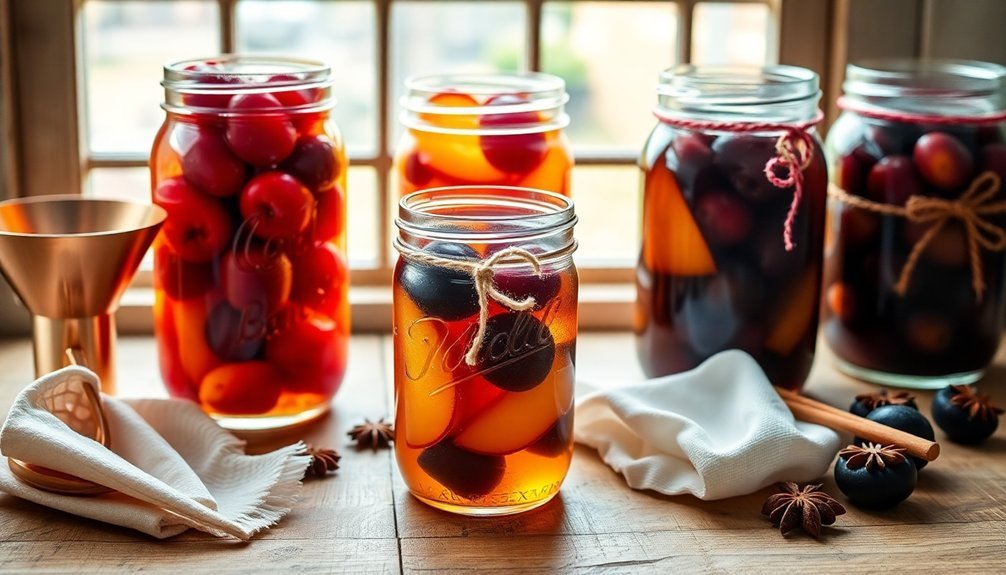
Creating a delicious brandied fruit compote requires a careful selection of ingredients and proper equipment.
You'll need to start with 2 cups of white wine and 1 cup of water as your base liquid. The sweetness comes from sugar, which you can adjust between 1/2 to 7/8 cup depending on your taste preferences.
Your dried fruit selection should include pear halves, plum halves, cherries, and golden raisins, while 1 to 1-1/2 tablespoons of brandy or fruit brandy adds depth and preservation. The different fruits require varying cook times, with pears, plums, and cherries needing about 15 minutes while raisins cook in just 3 minutes.
For spicing, you'll want to include a cinnamon stick, clove, vanilla bean, and bay leaf.
Don't forget you can enhance flavors with canned fruits, fresh produce, or citrus additions like orange juice and lemon juice. Alternative sweeteners such as honey, maple syrup, or agave can replace traditional sugar.
Equipment-wise, you'll need a stainless steel or medium saucepan for cooking, along with a slotted spoon for fruit removal.
Storage requires serving dishes or large clipped jars, plus airtight containers for refrigerated leftovers. Make sure you've got adequate cool storage space and remember to use loose lids to prevent pressure buildup during any fermentation.
Preparing Your Fruit Selection
With proper fruit selection, your brandied compote will develop rich, complex flavors. You'll want to choose a mix of both dried and fresh fruits, ensuring they're high-quality and at their peak ripeness. For dried fruits, select plump, moist varieties like pears, plums, and cherries.
If you're using fresh fruits, opt for ripe, bruise-free apples, raspberries, blueberries, or peaches. Consider the visual appeal of your compote by incorporating fruits of different colors and shapes.
You'll need to prepare your fruits carefully – slice them evenly for consistent cooking, and decide whether to peel them based on your preference. To prevent browning, sprinkle fresh-cut fruit with lemon juice. Remember that different fruits require different cooking times – pears and plums need about 15 minutes, while raisins only need 3 minutes. You'll need approximately one pound of fruit for a standard batch.
Pack your prepared fruit into sterilized jars, leaving ½ inch of headspace. Don't forget to add lemon or orange zest and vanilla bean to each jar for enhanced flavor.
If you're using organic produce, you'll avoid unwanted chemicals in your compote. Keep in mind that seasonal fruits will provide the best flavor and texture for your creation.
Building the Perfect Poaching Syrup
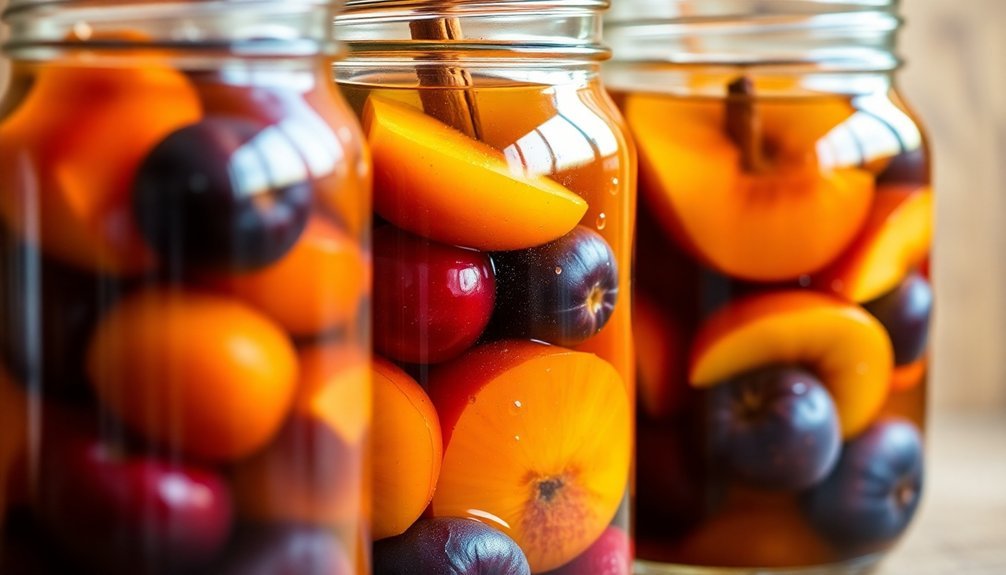
You'll need to strike the right balance between sugar and wine in your poaching syrup, with options ranging from light to medium sweetness and the ability to substitute wine for some of the water.
For under ripe fruits, use a mix of 1 cup sugar to 2 cups water for optimal results.
The perfect poaching liquid comes alive with essential spice combinations like cinnamon, star anise, and vanilla bean, while citrus zest adds brightness to the mix.
Keep your temperature control precise by dissolving the sugar over medium heat, then reducing to just below a simmer as you infuse the spices.
Balancing Sugar and Wine
Building the perfect poaching syrup depends upon striking a delicate balance between sugar and wine to preserve your fruit's texture while infusing rich flavor.
You'll want to choose a dry wine like Sauvignon Blanc or Cabernet Sauvignon, but don't splurge on expensive bottles since boiling removes the alcohol's bitterness while retaining the fruity qualities.
For the sugar ratio, consider your fruit's ripeness. If you're working with very ripe fruit, opt for a heavier syrup to prevent breakdown and maintain shape. Under-ripe fruit benefits from a lighter syrup, which allows for quicker cooking. A medium syrup using 1 1/4 cups sugar to 2 cups water provides an ideal balance for most fruits, effectively candying them while maintaining their structure.
To create your base syrup, combine sugar with cold water and heat until dissolved. Then add your chosen wine – red varieties like Cabernet or Merlot will contribute deeper flavors and rich color.
You can adjust the consistency by adding more water or reducing the mixture further. Remember to maintain a temperature just below simmer once you've achieved the desired balance of sweetness and wine.
Essential Spice Combinations
Three key spice combinations transform an ordinary poaching syrup into a complex, aromatic base for your brandied fruit compote.
For a classic sweet profile, you'll want to combine cinnamon sticks, star anise, and vanilla beans – this trio creates a warm, rounded foundation that complements most fruits.
If you're seeking a more exotic flavor, blend crushed cardamom pods with whole cloves and fresh ginger, which will add depth and a subtle heat to your compote.
For a bright, citrus-forward syrup, combine orange peel, lemon zest, and bay leaves. You can enhance this combination by adding a few sprigs of fresh herbs like rosemary or thyme.
Don't hesitate to adjust these combinations based on your fruit selection – for example, stone fruits work particularly well with warming spices like allspice and nutmeg.
Remember to lightly crush whole spices before adding them to your syrup to release their essential oils.
You'll want to strain these spices out before storing your compote, though you can leave a cinnamon stick or star anise for visual appeal and continued flavor development.
Optimal Temperature Control
The success of your brandied fruit compote hinges on maintaining precise temperature control during the poaching process. You'll need to keep your syrup between 160°F and 180°F (71°C to 82°C) to achieve the perfect consistency and preserve the fruit's texture.
Start by bringing your poaching liquid to a boil to dissolve the sugar completely, then reduce the heat to low. You'll know you've reached the right temperature when you see steam rising from the surface without any bubbling or movement in the liquid. Use a digital thermometer for precise readings, and adjust your heat setting as needed to maintain this ideal range.
For delicate fruits like raspberries and peaches, keep the temperature just below a simmer to prevent them from falling apart. If you're working with firmer fruits like apples or pears, you can afford to run slightly hotter, but still avoid boiling.
When using very ripe fruits, opt for a heavier syrup concentration to help maintain their structure. Conversely, if your fruits are under-ripe, you can extend the cooking time or increase the temperature slightly within the recommended range.
Proper Fruit Poaching Techniques
Mastering proper fruit poaching techniques guarantees your brandied compote achieves the perfect balance of tender fruit and rich flavor.
Start by preparing your fruits meticulously – peel and core apples and pears, pit stone fruits, and trim berries. You'll want to keep light-colored fruits submerged in lemon water to prevent browning while you work.
Create your poaching liquid by combining brandy with complementary liquids like wine, tea, or fruit juice. Add sugar or honey, along with your chosen aromatics, and heat until just below simmering. Let these flavors meld for 15 minutes before adding your prepared fruit.
Remember to maintain a gentle heat – you're looking for tiny bubbles, not a rolling boil.
- Watch in anticipation as your fruits slowly transform into jewel-toned treasures
- Breathe in the intoxicating aroma of warming spices and brandy
- Feel the satisfaction of perfectly tender fruit yielding to your testing knife
- Experience the joy of creating a heritage-worthy preserve
Arrange your fruits in a single layer and poach according to type: 10-25 minutes for firm fruits, 5-15 for stone fruits, and just 1-5 minutes for delicate berries.
Test doneness by inserting a knife – it should slide in effortlessly.
Brandy Selection and Addition
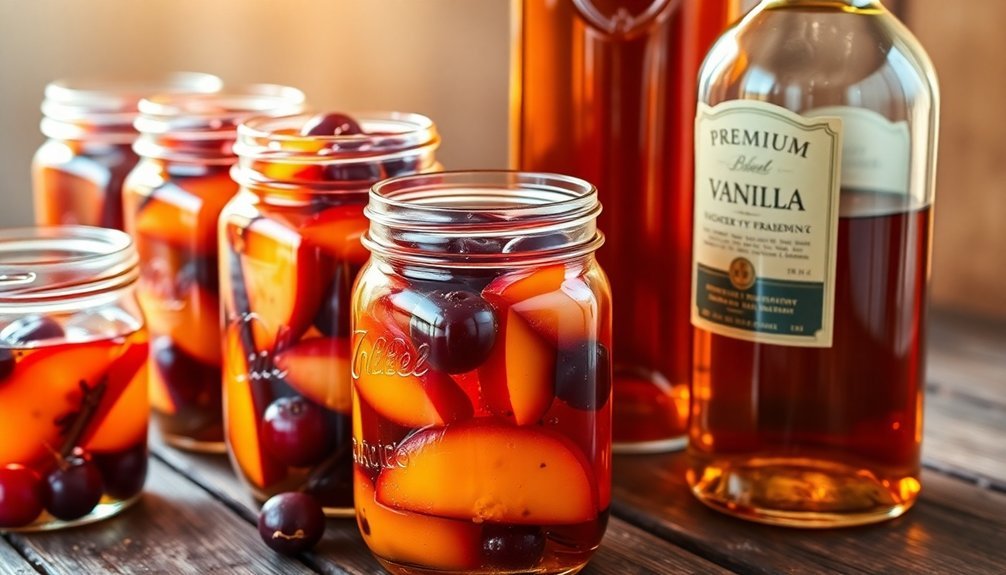
Selecting the right brandy forms the cornerstone of a memorable fruit compote. For delicate fruits like peaches and pears, you'll want to reach for a smooth Cognac, while fuller-bodied Armagnac works beautifully with robust fruits such as apples and cherries. If you're working with apple-based compotes, Calvados offers a natural complement with its fruity undertones.
You don't need to break the bank to achieve excellent results. Affordable options like E&J Brandy or Paul Masson provide reliable results, while supermarket own-brands can work just as well. For those seeking specific fruit pairings, consider Kirsch (cherry brandy) for stone fruits or peach brandy for tropical combinations.
When adding brandy to your compote, timing is essential. You'll get the best results by incorporating it toward the end of cooking or after the mixture has slightly cooled, preventing excessive alcohol evaporation.
Start with small amounts – you can always add more, but you can't take it away. For ideal flavor development, let your compote rest for several hours or overnight, allowing the brandy to fully infuse with the fruit.
Safe Storage Methods
To keep your brandied fruit compote at its best, you'll need to store it at the right temperature – either in the refrigerator at 2-4°C for up to two weeks or in the freezer at -18°C for up to six months.
You must use clean, airtight containers to prevent bacterial growth and maintain the compote's quality, leaving headspace if freezing to allow for expansion.
Don't forget to label your containers with the preparation date and keep them away from potential contaminants, ensuring you use clean utensils each time you serve.
Preserving Through Temperature Control
Proper temperature control stands as the cornerstone of safely preserving your brandied fruit compote.
You'll need to keep your compote outside the danger zone of 41°F to 135°F (5°C to 57°C), where bacteria can multiply rapidly, doubling in as little as 20 minutes.
When storing your brandied fruit compote, refrigeration at 0 to 7.2°C will help inactivate enzymes and slow microbial growth, extending its shelf life for weeks.
If you're planning for long-term storage, freezing at 0°F (-18°C) will effectively halt enzymatic activity and prevent bacterial growth.
When thawing your frozen compote, always use safe methods like refrigeration or cold running water to maintain food safety standards.
- Imagine serving a perfectly preserved compote that tastes just as vibrant as the day you made it
- Feel confident knowing your family's holiday tradition is safely stored
- Experience the satisfaction of maintaining your compote's rich flavors through proper temperature control
- Enjoy peace of mind as you preserve precious seasonal fruits for future celebrations
Remember to cool hot compote quickly using shallow containers or ice baths, bringing it to 70°F within two hours and 41°F within four additional hours for ideal safety.
Airtight Container Best Practices
Beyond temperature control, your brandied fruit compote's longevity depends heavily on the containers you choose for storage. Select food-grade silicone or glass containers with airtight, leak-proof seals to prevent alcohol evaporation and maintain the compote's quality. Verify your containers have reinforced corners and secure snap-on lids to protect against accidental spills.
Before storing your brandied compote, wash containers thoroughly with warm, soapy water and let them air dry completely. Pay special attention to the lid's edges and corners where residue often accumulates. Sanitize the containers to eliminate any bacteria that could compromise your preserve's safety.
Label each container with the preparation date and contents, as you'll want to use older batches first. If you're making multiple varieties, clear labeling prevents confusion and helps track your inventory. Store your containers in a manner that allows easy access and regular inspection for any signs of spoilage.
Don't stack containers until you're certain they're completely sealed and secure. Keep them organized in your storage area, making sure the lids remain tightly closed to maintain the brandy's preservation properties and prevent contamination.
Extending Your Compote Shelf Life
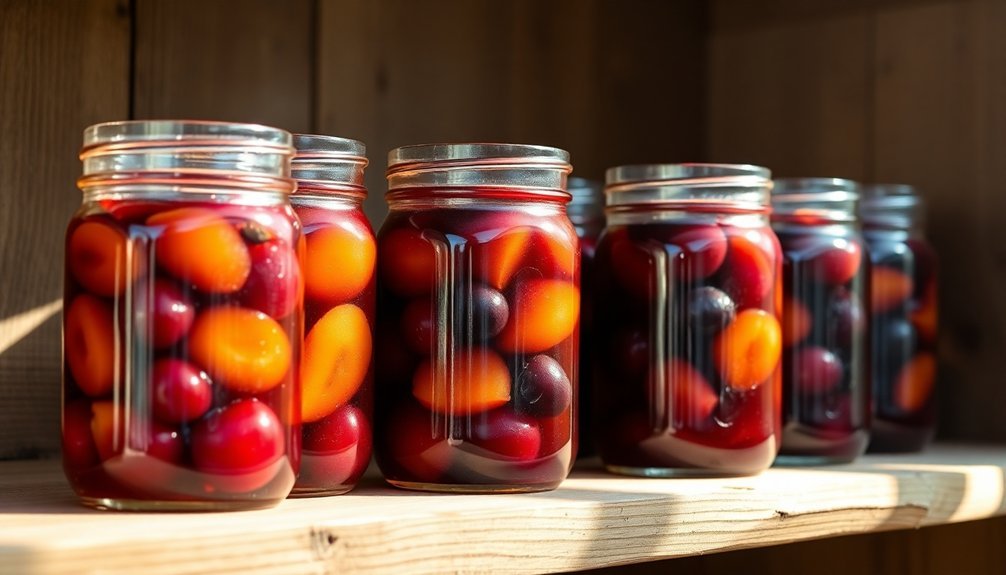
Making your brandied fruit compote last longer requires careful attention to storage and maintenance techniques.
You'll want to keep your compote in a cool, dark place for at least 3 weeks, and if you're aiming for extended shelf life, refrigeration can preserve it for up to 9-10 months.
Remember to keep the fruit completely submerged in the brandy or cognac mixture, as exposure to air can lead to spoilage.
To maintain ideal preservation, regularly top off your jars with additional brandy or cognac as you use the fruit.
The combination of sugar and alcohol acts as a natural preservative, but you'll need to use at least 80-proof spirits for effective results.
Don't forget to shake the jars periodically, especially during the initial weeks, to guarantee even distribution of flavors.
- Imagine serving your perfectly preserved compote at holiday gatherings months after preparation
- Picture the satisfaction of having homemade brandied fruit ready whenever inspiration strikes
- Feel confident knowing your preserved fruits are safely stored and properly maintained
- Experience the joy of sharing your long-lasting creation with friends and family throughout the season
Canning Process for Long-Term Storage
You'll need to start by thoroughly sterilizing your glass jars and lids in hot water to guarantee a safe canning environment.
Process your brandied fruit compote at a rolling boil for 15-20 minutes, depending on your altitude, with jars submerged in the water bath canner.
Watch for the telltale "pop" of the lids sealing as they cool, and test each seal by pressing the center of the lid to confirm it doesn't flex or move.
Sterilizing Glass Jars
Proper sterilization of glass jars stands as the foundation of safe, long-term fruit preservation. You'll need to choose between two effective methods: the oven method at 275 degrees for 10 minutes or the boiling water method for at least 10 minutes. If you're at a higher elevation, add an extra minute of boiling time for each 1,000 feet above sea level.
Start by washing your jars and lids in hot, soapy water and rinse thoroughly. Don't dry them – this helps prevent contamination. While your jars are sterilizing, soak the lids in boiling water for five minutes to soften the rubber seals. You'll want to keep both jars and lids warm until you're ready to fill them.
- Imagine the satisfaction of hearing each lid "pop" as it seals perfectly
- Picture your pantry filled with gleaming jars of brandied fruit
- Think of the pride you'll feel serving your homemade compote
- Envision your family's delight at tasting your preserved creation
Remember to use a jar lifter or tongs when handling hot jars – avoid oven mitts as they can become waterlogged and dangerous.
Once filled, place your jars on a folded kitchen towel to cool completely before checking the seals.
Processing Times and Temperatures
Successfully preserving your brandied fruit compote depends on precise processing times and temperatures that vary with altitude. For altitudes up to 1,000 feet, process your jars for 15 minutes. If you're between 1,001 and 6,000 feet, increase the time to 20 minutes. Above 6,000 feet, you'll need to process for 25 minutes.
You'll want to maintain a boiling temperature of 212°F at sea level throughout the process. When combining different fruits in your compote, always use the longest recommended processing time among your chosen fruits.
Make certain you're only using acidic fruits with a pH below 4.6, and avoid non-acidic options like papaya or ripe mango.
Before processing, heat your fruit mixture to boiling and pack it into hot jars, leaving ¼ inch of headspace. Remember to cook your fruits slowly with sugar and water until they're soft.
Store your finished compote at temperatures between 50°F and 70°F, and avoid the danger zone of 40°F to 140°F where bacteria thrive. Following these precise times and temperatures guarantees your brandied fruit compote remains safe and delicious for long-term storage.
Proper Sealing Methods
The jar-sealing process stands as the critical final step in preserving your brandied fruit compote. Before sealing, you'll need to wipe the jar rims carefully to remove any sticky residue that could prevent a proper seal.
Apply your sterilized two-piece lids according to the manufacturer's guidelines, ensuring they're firmly secured but not overtightened.
For the best results, you'll want to follow these essential steps while the jars are still hot from filling. Make sure you're working with clean hands and sanitized equipment throughout the process.
Once you've secured the lids, let the jars cool completely before checking the seals.
- You'll feel a deep sense of satisfaction when you hear that distinctive "ping" sound of a properly sealed jar.
- There's nothing quite like seeing rows of perfectly sealed jars lined up in your pantry.
- You'll experience pride knowing you've preserved nature's bounty for months to come.
- The peace of mind from knowing you've properly sealed your preserves is invaluable.
If any jars haven't sealed properly, don't worry – just store them in the refrigerator and use them first.
Remember to check that your fruit stays submerged in the brandy mixture during storage.
Signs of Spoilage
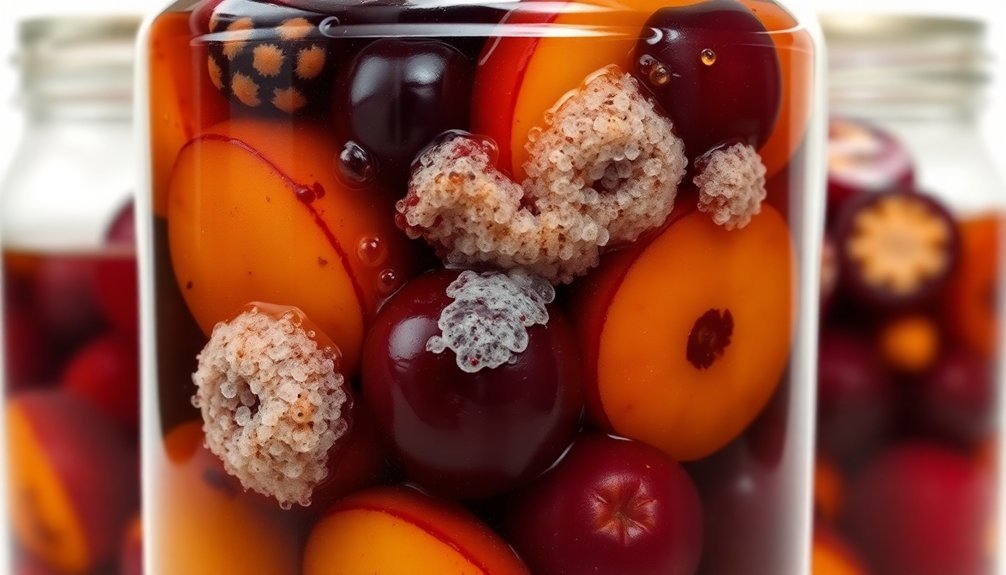
Identifying spoilage in your brandied fruit compote relies on four key indicators: visual cues, smell, texture, and storage conditions. Watch for darkening or browning, which indicates oxidation, and any fuzzy spots that signal mold growth. If you notice unusual colors or excessive separation, it's time to discard the compote.
Trust your nose – it's one of your best tools for detecting spoilage. You'll want to watch out for fermented, sour, or vinegar-like odors. If your compote has lost its characteristic fruity aroma, that's another red flag.
| Spoilage Indicator | When to Discard |
|---|---|
| Visual | Any mold, dark spots, or unusual colors |
| Texture | Slimy, overly thick, or grainy consistency |
| Smell | Sour, fermented, or off-putting odors |
The texture should remain consistent with your original preparation. If you notice sliminess, excessive thickening, or a grainy feel, these changes indicate spoilage. Pay attention to your storage practices too – using non-airtight containers or frequent opening and closing can introduce harmful bacteria. Always maintain proper refrigeration below 2°C and avoid cross-contamination with other foods in your fridge.
Creative Serving Suggestions
Brandied fruit compote shines as a versatile addition to countless dishes, from breakfast staples to elegant desserts. You'll find endless ways to incorporate this flavorful treat into your daily meals and special occasions.
Start your morning by spooning the compote over oatmeal, waffles, or yogurt for a luxurious breakfast upgrade. For desserts, pair it with vanilla ice cream, cheesecake, or pound cake to create sophisticated endings to your meals.
Transform your beverages by adding a spoonful to cocktails, sangria, or even hot chocolate for an unexpected twist. When entertaining, serve the compote alongside afternoon tea or use it to elevate simple fruit salads. You can also incorporate it into parfaits or use it as a creative filling for crepes and pastries.
- Imagine the warmth of fresh-baked French toast drizzled with brandy-kissed fruit compote
- Picture guests' delight as they discover this secret ingredient in your signature holiday punch
- Envision the comfort of a winter evening with compote-topped hot chocolate
- Consider the elegance of serving crystal bowls of compote-enhanced trifle at your next dinner party
Frequently Asked Questions
Can I Substitute Non-Alcoholic Ingredients for the Brandy?
Yes, you can swap brandy with unsweetened fruit juices (use half the amount), diluted apple cider vinegar, broth, or verjus blanc. Each option brings unique flavors while maintaining moisture in your recipes.
Is It Possible to Reuse the Poaching Syrup for Multiple Batches?
Yes, you can reuse your poaching syrup multiple times. Just reboil it before each use to guarantee safety. While the flavor may change slightly, it'll remain safe if you store it properly in the fridge or freezer.
What Happens if I Accidentally Over-Poach the Fruits?
If you over-poach your fruits, they'll become mushy and lose their shape. You'll notice the texture turning unpleasantly soft, flavors becoming too intense, and colors fading. The fruit might even fall apart completely.
Can I Mix Different Types of Brandies in the Same Batch?
Yes, you can mix different brandies in the same batch. Start with small test combinations to guarantee the flavors complement each other. Remember that matching fruit brandies with their corresponding fruits works especially well.
Does Altitude Affect the Poaching Time or Storage Requirements?
You'll need to increase poaching time at higher altitudes since water boils at lower temperatures. However, altitude won't affect your storage requirements – just follow standard food safety guidelines for preservation and refrigeration.
In Summary
You'll find this homemade brandied fruit compote adds a special touch to your holiday celebrations. Whether you're spooning it over ice cream, stirring it into cocktails, or gifting jars to friends, your efforts in proper preparation and storage will guarantee months of enjoyment. Remember to check regularly for signs of spoilage, and don't hesitate to experiment with different fruit and brandy combinations to create your signature blend.

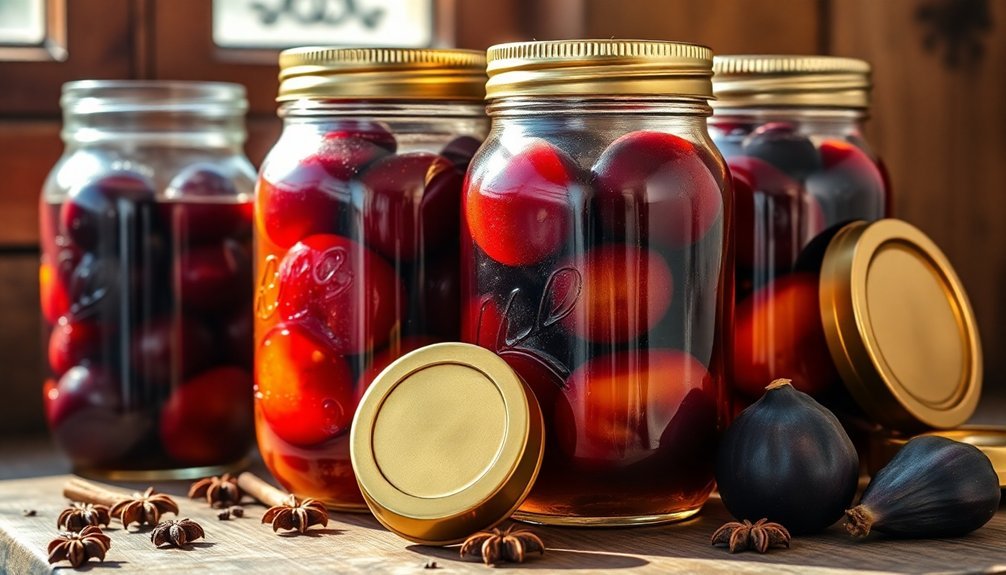



Leave a Reply